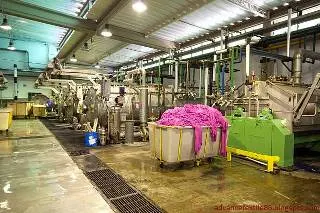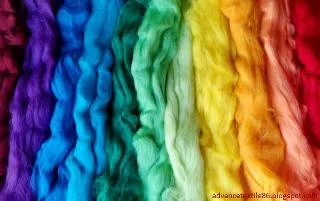Textile wet processing
Textile
wet processing is one of the major streams in textile engineering refers to
textile chemical processing and applied science. It is usually done on the
manufactured assembly of interlacing fibers, filaments, or yarns having a substantial surface area in relation to their thickness, and adequate
mechanical strength to give it a cohesive structure.
An alternative way to say, the wet process is done on manufactured fabric. The
processes of this stream are carried out in an aqueous stage and thus it is
called a wet process which usually covers pretreatment, dyeing, printing, and
finishing. All of these stages are required an aqueous medium that is created
by water. These processes require plenty of water every day. It is estimated
that, on average, almost 100-110 liter of water is used to process only 1 kg of
textile goods. Water can be of various qualities and attributes. Not all kinds
of water can be used in the textile process, it must have certain characteristics,
quality, color, and properties to be used in the textile process. That is why
wet processing is concerned with water.
Some dyeing process
Dyeing
is the process of adding color to textile products such as fiber, yarn, and
fabrics. It is usually made in a special solution containing dyes and certain
chemical ingredients. Dye molecules have an unnecessary chemical bond with the
fiber molecules after dyeing. Temperature and time control pigmentation are the
two main factors. There are different classes of dyeing, all types of dyeing
are as follows-
Solution dyeing
Solution
dyeing is also called dope or span dyeing, it is the process of adding pigment
or dissolved pigment to the spinning product before it comes out of the
solution through the spinneret solution. Only the fibers produced can be dyed
with a solution. It is used for hard-to-dye fibers such as olefin fibers and
for dyeing fibers for the final color that require excellent coloring
properties. As color dyes become part of the fiber, soluble dyes have good
colorfastness for light, wash, abrasion, perspiration, and bleach. Dyeing at
the solution stage is more expensive, as the equipment has to be thoroughly
cleaned each time a different color is produced. Thus, a small variety of
colors and shades is produced. Besides, it’s hard to stock inventory for each
color. Color decisions should be made early in the manufacturing process. Thus,
this stage of coloring is not usually used for clothing.
Gel dyeing
The
filament fibers that are made using the wet spinning method can be dyed while
the fibers are still in the frozen bath. This method is known as gel dyeing
because the fibers are still soft.
Fiber dyeing
Different
types of dyeing are done for fiber dyeing. The names are indicated on the stage
when it is drawn when the fiber is. All three cover a wide range of fiber
dyeing.
Stock
dyeing is the process of dyeing raw fibers, also called stock, before they are
aligned, blended, and cut into yarns.
Top
dyeing is dyeing to remove short fibers after shortening the worse fibrous
fibers. This stage is known as the wool fiber top. Top dyeing is preferred for
bad fur because the pigment does not have to be wasted on the small fibers
removed during the attachment process.
Tow
dyeing is the dyeing before the filament fibers are cut into short staple
fibers. At this stage, the filament fibers are known as tow.
The
penetration of the dye in the fiber dye is great, so the amount of dye to dye
at this stage is even greater. Fiber dyeing is comparatively more expensive
than yarn, fabric, and garments dyeing. The decision about color selection
should be made early in the production process. Fiber dyeing is commonly used
to dye wool and other fibers that are used to make yarn with two or more dyes.
Fibers for tweeds and fabrics with heather hues are often fibrous hues.
Yarn dyeing
There
are different types of yarn dyeing. Common forms are package form and hank
form. Cotton yarns are mostly dyed in package form, and acrylic or wool yarn is
dyed in hunk form. In the continuous filament industry, polyester or polyamide
yarns are always dyed in package form, while viscose rayon yarns are dyed
partly in hunk form due to technology.
Fabric dyeing
This
is called piece dyeing; it is fabric dyeing after making. This is the most common
method of dyeing for fabric that is economical and densely used for coloring.
The color decision can be made after the fabric is made. Thus, it is suitable
for quick response orders. Dye penetration into dense fabrics may not be good,
so yarn dye is sometimes used to dye on dense fabrics. Different types of
dyeing machines are used to color the pieces. Equipment selection is based on
factors such as dyes and fabric properties, cost, and intended end-use.
Union dyeing
It
is a process of dyeing where a fabric containing two or more types of fibers or
yarns to the same shade so as to achieve the appearance of a solid-colored
fabric. Fabrics can be dyed using single or multiple steps. Union dyeing is
used to dye solid colored blends and combination fabrics normally used for
apparel and home furnishings.
Cross dyeing
Cross
dyeing is a type of dyeing where blend or combine fabrics into two or more
shades by the use of dyes with different affinities for the different fibers.
The cross-dyeing process can be used to create heather effects and to create
plain, check, or striped fabrics. Cross-dyed fabrics can be mistaken for fiber
or yarn-dyed materials because the fabric is not a solid color, considered a
feature of piece-dyed fabrics. It is not possible to visually differentiate
between cross-dyed fabrics and those dyed at the fiber or yarn stage. An
example is cross dyeing blue worsted wool fabric with polyester pinstripes.
When dyed, the wool yarns are dyed blue, whereas the polyester yarns remain white.
Cross dyeing is commonly used with pieces of fabric dyed materials. However,
the same concept applies to yarn and product dyeing. For example, embroidered
silk fabric with white yarn can be dyed and embroidered before placing an order
to dye the product.
Garments dyeing
Garments
dyeing is also known as product dyeing, is the process of dyeing products such
as hosiery, sweaters, and carpet after they have been produced. This stage of
dyeing is suitable when all components dye the same shade. This method is used
for perfect hosiery dyeing as it is knitted using a tubular knitting machine
and then sewn before dyeing. Tufted carpets, with the exception of carpets
produced using solution-dyed fibers, are often dyed after they have been
tufted. This material is not suitable for garments with many elements like
lining, zippers, and knitting threads, as each material can be colored
differently. The exception is tinting jeans with pigments for a vintage look.
Dyeing
is used in tinting, while chemical or mechanical processes are used in
acid-wash and stone-washing. After garment construction, these products are
given the faded or used look by finishing methods as opposed to dying.
Dyeing
at this stage is ideal for a quick response. Many T-shirts, sweaters, and other
types of casual wear are product colored in response to the fashion demand for
certain popular colors. Thousands of garments are constructed from
prepared-for-dye fabric and then dyed to colors that sell best.















0 Comments